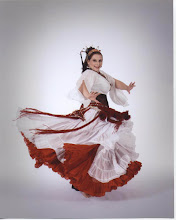So last time we stopped with the advent of Islam ...
This truly affected the world of the Middle East. Islam spread and with it came new ideas and feelings about women and dance. I'm not interested in discussing whether there was some ultimate "right" or "wrong" about these ideas. The ideas simply "are". The effect was to contain and marginalize women's roles in a changing society and that directly affected their dance.
Since women became more contained, the examples of public dancing became more scarce. Islam completed the removal of dance as a sacred and religious experience and moved it firmly into the secular realm. Certainly there were fringe examples of dance being associated with the sacred ( think Zar and the dancing that took place at weddings and the Saints tombs), but by and far dance became firmly secular. Women continued to dance in the privacy of their homes, "proper" women did not dance in public. There are always exceptions, but in general this still holds true today with female public performers being looked down upon and even in certain cases being sued by others for "inciting men".
So, during the middle ages, secular dance moved into the streets and into the "hands" of the street prostitute. Much of our information from this period is from sources who only had access to street performers and prostitutes and their movements and life. The images begin to move from those of graceful performers with sweeping arm gestures to the intensive hip orientation that is found today in belly dance. Certainly there were hip movements prior to this time period - Roman writers describe them and their are depictions from the ancient world that show hip work or a hip emphasis in costuming. But the writings and the images become more hip oriented once the dance hits the streets.
As the Renaissance starts more and more European travelers begin to comment on the "dancing girls of the east" and the beginnings of the fascination with them can be found. Still most of these women are street performers, courtesans, and prostitutes. I haven't found any accounts of the average woman performing in front of the visitors. Not to say it never occurred, just that I haven't found such an account. Please share if you know of one!
But the height of the "dancing girl" accounts comes during the Orientalist period of the 1800's. And with it comes much insinuation of the sexual aspects of the street prostitute and courtesan. Those images and stories greatly affected how the Western World viewed belly dance. The dance became intricately tied to the sexual aspect and the long lost folk and sacred aspects were left to history.
My point with this very abbreviated generalist history is that there were many things that affected what we know today as belly dance. By the time the West discovered the dance, it had already been through many incarnations. So while the bones of the dance, the soul of the dance might stretch back through time to a place where it held religious and sacred aspects, by the time it reached the West those days were long gone.
Just as the purpose of the dance had changed, so had the movements. While some were similar being hip driven and body driven verses footwork and sweeping arm movements as many Western dances were, much was added. Life is change. Artists are influenced and adopt the new trends and street performers more than court performers use what is popular and trendy. They must keep the interest of the populace and don't generally concern themselves with maintaining a cultural purity unless that is what is popular. So as the cultures blended with each Empire change so did the art of belly dance. New musical phrases and dress were introduced and this influenced the movements. Conquered entertainers were imported and were all the rage for their exotic differences and so the locals adopted those differences in order to keep their customers.
Now here is the hard part. It is simple enough to see that both purpose and movements changed - but HOW had they changed? This is the difficult if not impossible question for a dance historian to ask themselves. As the dance comes to the notice of the West, how "pure" is it? What forces have already influenced it?
Next time, we'll look at the changes that happened once the dance was introduced to the West...
Subscribe to:
Post Comments (Atom)




No comments:
Post a Comment